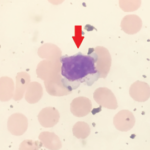Fevers & Back Pain
Children with arthralgias but normal joint exams may present with other symptoms, such as prolonged fevers. In these cases, patients may need to be admitted to the hospital for thorough malignancy and infection workups, Dr. Miller said. An echocardiogram helps detect other causes of pain with fevers and other symptoms, such as non-specific rashes. These include coronary arterial aneurysm, Kawasaki disease, thickening of the mitral valve or pericardial effusion in children with systemic JIA. Depending on the particular presentation, auto-inflammatory diseases may need to be considered.
“Even if one doesn’t hear a heart murmur, but the patient has adenopathy, fevers and non-specific rash—along with arthralgias—think about [ordering] an echocardiogram. It’s a good routine test,” said Dr. Miller.
Back pain has a broad differential diagnosis in children. Dr. Miller shared a case of a child with persistent, moderate to severe back pain and trouble walking, but a normal examination and X-rays. An MRI revealed intraspinal metastatic lesions. This patient was later diagnosed with acute lymphocytic leukemia.
Children cannot always localize back pain. “I often can’t use a child’s or parent’s reported history to determine what part of the spine to image. I have seen abnormalities in the MRI not located where they were reporting the pain,” Dr. Miller said.
Back pain may occur in spondylolisthesis; infections, such as intraspinal abscess or vertebral osteomyelitis; tethered cord; syrinx; Chiari malformation; spinal cord tumors; or acute lymphocytic leukemia.
Children with back pain who cannot walk should always be admitted to the hospital for further evaluation, said Dr. Miller. Possible diagnoses associated with these symptoms include early septic arthritis, early osteomyelitis, spinal abscess or tumor, as well as physical or sexual abuse.
Use structured interviews, and collaborate with social workers and mental health professionals to screen for abuse or psychiatric problems that cause pain in children. Targeted MRI has replaced bone scans in identifying potential malignancies that may cause walking problems in children, followed by biopsies to confirm the diagnosis.
Weakness
Proximal muscle weakness may be a sign of inflammatory muscle disease. However, it is worth asking adolescents if they lift weights, because this can elevate creatine phosphokinase levels, Dr. Miller said.
“Laboratory and muscle biopsies will exclude muscular dystrophy,” he said. Creatine phosphokinase is an important test for children with weakness. Elevated levels may result from dermatomyositis or polymyositis. Marked elevation suggests muscular dystrophy. Severe elevation may mean rhabdomyolysis. “If [creatine phosphokinase] is normal, consider chronic inflammatory muscle disease or other non-inflammatory causes.”



